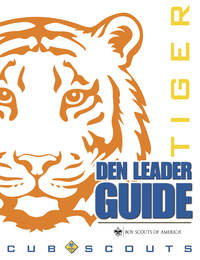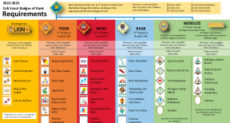 School starts in most places in just a few weeks, which means we’re heading into our big recruiting season. Packs will be going out into the schools to spread the word about Cub Scouting, enticing boys with the thrill of adventure, exploration and fun, and hoping they’ll run home to tell their parents that they want to join.
School starts in most places in just a few weeks, which means we’re heading into our big recruiting season. Packs will be going out into the schools to spread the word about Cub Scouting, enticing boys with the thrill of adventure, exploration and fun, and hoping they’ll run home to tell their parents that they want to join.
We’re also going to be recruiting their parents as den leaders, committee members and even Cubmasters. Without adult volunteers, Scouting simply wouldn’t exist.
Recruiting boys is relatively easy. They’ll go for anything that appeals to them, and Cub Scouting has it all – and then some.
But recruiting adults is another story. Most adults are already pressed for time, and those just coming in to Cub Scouting don’t know anything about the program or what it takes to run it.
There is lots of material available. For many years we have been telling leaders in training sessions that there are a lot of resources from the BSA as well as from third parties. Den Leader guides, the Cub Scout Leader Book, the How-To Book, the Ceremonies book, the Uniform Guide, Guide to Advancement, the now-retired Academics and Sports program. Outside resources like Baloo’s Bugle. Training, both online and in-person. Monthly Roundtables. The BSA website is teeming with information on the new program with page after page, PDF after PDF to wade through.
It can be overwhelming!
That’s an observation that incoming Chief Scout Executive Michael Surbaugh made in an interview with NOAC Nightly News anchor Kevin Montano at least week’s National Order of the Arrow Conference at Michigan State University. Surbaugh said:
Scouting is as relevant as it’s ever been. In fact, I think it’s even more relevant to the needs of today’s youth. Sometimes, our delivery isn’t seen as relevant. We don’t have the easiest execution model, and we have a program that’s been built up and layered on for 105 years. So we have a lot of “stuff”. And I think that it’s going to be important in the next generation of Scouting, to take the leadership, the character, the fitness – all of our core values – and streamline our program so it’s a little bit easier to deliver.
Surbaugh spoke from personal observation that the learning curve for new leaders is steep:
I had a chance to see a Cub Scout pack that was being organized, and there was a gentleman there who was probably about 30 years old and he had a son and he was willing to make the commitment to be a den leader. But as he was looking at the tables full of resources we had – and a very enthusiastic Cub Scout leader was saying “we have this, and we have this, and this book, and you can take this training, and there’s another day training you can take, and you can come to Roundtable every month. And then there’s the Internet resources.” – finally, he stops, and [the new leader] said “Dude – just tell me what to do!” And I think that’s what today’s millennials – the volunteers and the parents that we’re trying to attract – are really looking for. Give me the training I need when I need it, make the program simple for me to operate, and I’m willing to participate. So I think we overwhelm people with all the good stuff we have.
Use the best resources
Fortunately, the program experience folks at the BSA are coming around to the notion that more is not necessarily better. The new Cub Scout program guides are available now. They’re more streamlined and better organized than program guides of the past. They provide leaders with step-by-step directions for planning den meetings, including games, activities, materials lists and helpful information for planning ahead. Here’s a sample of what’s in the new guides.
Don’t drink from the firehose
As Surbaugh mentioned, there is so much material available that if taken all at once, new volunteers can be extremely confused about what they learned and in what context it applies. New leaders need to know what they need to do today, this week and this month – not be overwhelmed by supplemental training and volumes of additional material that they won’t need for weeks, months or years – or ever. The big picture is important – but with the proper guidance up front, it will come in due time.
Some suggestions
New volunteers stepping into a leadership position should consider these “baby steps” to get started:
- Youth Protection Training is an absolute must before a volunteer can even register. Sign up for an online account at myscouting.org and take the training there.
- Go online and read the sample den meeting plans. It’ll give them a good idea of what they are expected to do, and what kind of resources the BSA will provide them with. Then obtain the full version from the nearest Scout Shop (it’ll have a cover like the one pictured above) or order from scoutstuff.org.
- Take the online position-specific training for their leadership position within the first couple weeks after signing up, and preferably before meeting with the den for the first time. (It’s available at myscouting.org as well.) This will help them get off on the right foot.
- If it’s convenient, attend Roundtable – at least once during the first three months. If a new leader can make it a habit, they’ll get hooked on the fellowship and resources available.
Other things can wait, and should be checked out eventually, but these few things will get them going in the right direction. As experience and curiosity build, and the desire to “up” the program for the boys, Â they should gravitate toward additional resources.
It’s more fun with two
As with almost everything, sharing an experience makes it that much better. A new den leader should pair up with either an experienced leader or another parent in his or her son’s den (who should be registered as an assistant Den Leader). Then, sit down with your helper to prepare for the next one or two den meetings. Don’t try to map out several months’ worth at first – just concentrate on next week’s meeting. Go over the materials with your assistant and decide how to share the preparation responsibilities, as well as who will run the activities. (Tip: Try to find a time when you can meet on a different day from the den meeting. Trying to meet before or after means you have anxious boys to deal with.)
Being a new den leader can be daunting, as I’m sure you know from personal experience. If you’re reading this, chances are good that you were a brand-new den leader yourself at one time. Let’s go out and “wow” our boy recruits but not overwhelm our adult recruits.
You might also be interested in the following resources:
- Cub Scout Leader Survival Guide, a series of five articles by Clarke Green
- So You’re a New Den Leader [PDF] – what we’ve been telling new volunteers about their role
- Cub Scout Ideas – a website with a variety of inspirational posts to help Cub Scout leaders





Many packs don’t fill the key leadership and administrative roles successfully. People are put in roles on paper solely to facilitate rechartering – this leaves units precariously positioned. A strong key3 is really important, but a pack also needs a qualified pack trainer that can help the leaders stay abreast of training requirements and opportunities as well as help groom new and developing leaders.
Dustin,
Thanks for the comment. I strongly agree! Pack trainer is an under-utilized position, and can be valuable in the success of the pack leadership, but it’s a tricky position to fill. You really need someone with experience (it’s not a job for a new recruit), and unfortunately a pack is usually using that person in a more active role such as Cubmaster or committee chair. If you have a “retired” leader who maybe doesn’t want an active program role, that’s a good job for them.
An active and involved unit commissioner is helpful in guiding the pack Key 3 in the right direction. The only problem with commissioners is the same as it is with Boy Scouts – there aren’t enough of them!
Our Council is in its second year of implementing “Tiger Time!” which is the Cub Leader program for “Tiger Parents” and their kids. We DON’T say it’s for “Tiger Leaders” because we want all Tiger parents to attend whether they’re going to be a registered leader or not.
The jist of it is we block out 4 hours on a Saturday. We have Venture scouts who take the children and go play with them, do some Scouting stuff, etc. while the parents are taken and given the training.
When the adults leave, everyone is “trained” for that position whether they become a registered leader or not. This way, the parents know what the den leaders know and can help as well as understand the scouting process. (and the kids have fun, too.)
it’s a win-win-win-win. 🙂
Mike,
This is a terrific idea! Tiger (and to some extent, Wolf) is the main entry point for volunteers in all of Scouting, and to get them oriented, in a fun way, from the get-go is a great way to involve more people in the long run. I’d like to see some figures on how this impacts percentage of Trained leaders as well as volunteer retention (and consequently, youth member retention too).
New Cub leader ramp-up has been a huge weakness for years. It is somewhat better now. Formerly, if you followed the Program Helps, the Cubs did not advance.
My Wood Badge patrol had two Cub leaders. Both of us chose one or more ticket items to help new leaders. One of mine was teaching notes for Wolf. These are based on the 2003 requirements, but I expect they are still somewhat useful
http://wunderwood.org/wolfnotes/wolfnotes.shtml